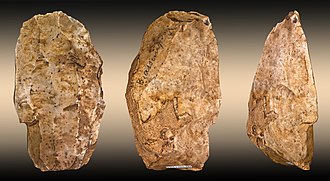Core (archeology)
The core is the starting piece (prepared raw piece) for the production of cut stone artifacts during the Stone Age and more recent periods of prehistory (for indigenous peoples of North and Central America up to the early modern period).
The raw piece consists of amorphous or cryptocrystalline rock ( chalcedony , flint , jasper , silica slate , shell limestone , quartz , quartzite , rock crystal , rhyolite , obsidian, etc.), which results in a mostly shell-like fracture ( brittle fracture ) with typical impact characteristics.
Rock from which at least one cut was cut off in the brittle fracture is thus a core. A typical feature is the concave surface (negative) that is created after splitting off. Planned cores have at least one striking surface, i.e. the surface on which the striking stone or mallet (made of antler, bone or ivory) hits or the punch (intermediate piece made of antler, wood or ivory) is placed. While a knock-off core can be struck for this purpose without contact with a striking surface, in the case of a blade core it is always necessary to have a striking surface and a guide ridge to control the blade separation.
If the core is retouched , it becomes a core device, whereby this can either have been specifically manufactured (for example hand ax or blade tip ), in other cases it is only a secondary product (for example a blade core that is used as a keel scraper ).
See also
literature
- Joachim Hahn : Recognition and determination of stone and bone artifacts. Introduction to artifact morphology (= Archaeologica venatoria. 10). 2nd Edition. Verlag Archaeologica venatoria et al., Tübingen 1993, ISBN 3-921618-31-2 .
- Harald Floss (Ed.): Stone artifacts from the Old Palaeolithic to the modern age. 2nd Edition. Kerns, Tübingen 2013, ISBN 978-3-935751-16-2 .
